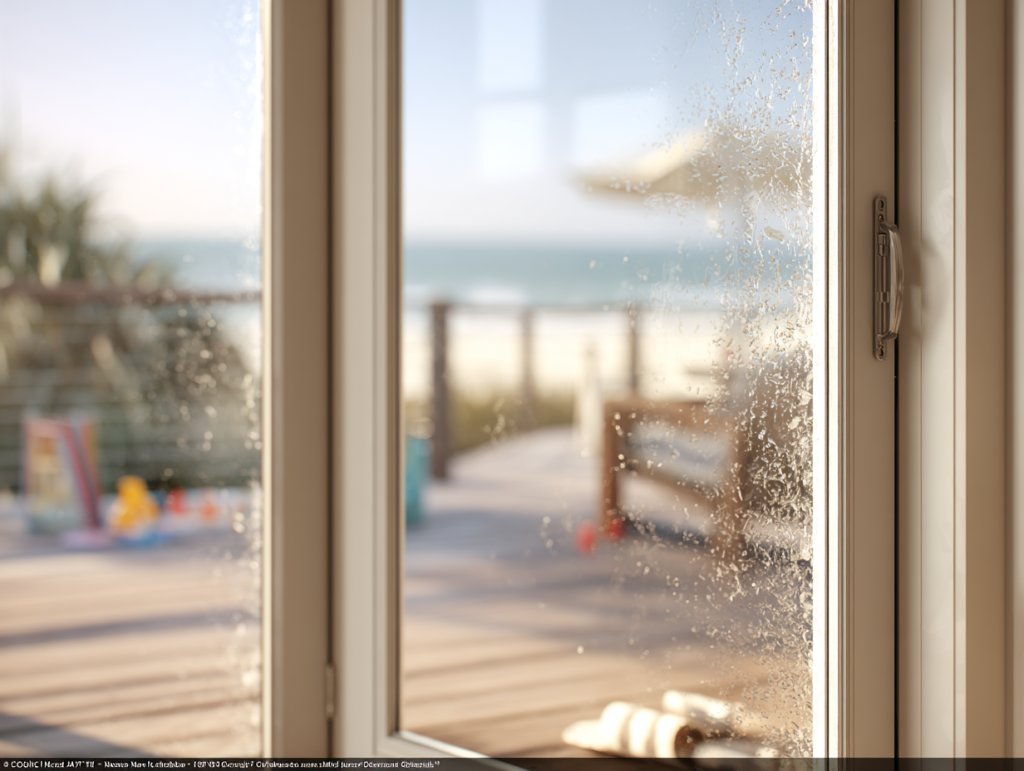
Living in Destin is like having a permanent postcard view. Turquoise water, sea breeze, sunsets that look edited. But here’s the twist none of the travel brochures mention — that same salty air that makes life here magical can quietly destroy your home.
A few years back, I had a client call me in a panic. “My windows look cloudy from the inside, can you fix that?” When I arrived, one glance told the story — it wasn’t the inside at all. It was months of salt residue baked into the glass like mineral cement.
See, sea spray carries microscopic salt particles. You don’t really notice them floating around, but they land everywhere — glass, siding, patio furniture, railings, outdoor kitchens, even your car if it sits outside long enough. The sun does the rest of the job by crystallizing it into a milky haze that no rainstorm will wash away.
And here’s the tricky part: salt doesn’t just look bad. It eats surfaces over time.
- On glass, it creates etching that starts permanent damage if ignored too long
- On metal fixtures, it speeds up corrosion (yes, even on “rust-resistant” finishes)
- On painted surfaces, it works its way into microcracks like sandpaper
- On outdoor furniture, it breaks down protective coatings faster than normal wear
Most homeowners think, “Oh, it’s the beach — a little fog on the windows is normal.” Sure, until you realize normal turned into damage.
The worst cases aren’t even the homes right on the sand. It’s the properties 300–1,500 feet from the shore. They don’t get the dramatic ocean mist, so owners assume they’re safe… but the wind delivers salt like a silent subscription service — steady, invisible, and non-cancellable.
That day with those windows? We spent hours restoring the glass properly — not just “wiping it clean.” It required a full demineralization process and protective sealing afterward. The client looked at me and said, “I had no idea the ocean was so high-maintenance.”
I laughed and replied, “It’s low-maintenance to admire. High-maintenance to live next to.”
Once you understand salt is constantly working against your home, the goal shifts from “remove it when I see it” to “stop it before it builds up.” In coastal towns like Destin, cleaning isn’t cosmetic — it’s preventative maintenance, like changing the oil in your car.
Here’s the routine I swear by after a decade of fighting salt on every surface imaginable:
1. Glass needs more than glass cleaner
Typical window spray doesn’t dissolve mineral salts. It just smears them around like sunscreen on a mirror. To truly remove buildup, you need a demineralizing or mildly acidic solution (professional-grade, not household vinegar), followed by a rinse that leaves zero residue. After deep cleaning, a hydrophobic glass sealant buys you months of protection.
2. Metal hates to admit it’s aging — until it’s too late
Outdoor fixtures claim they’re “rust-resistant.” That’s marketing for “rusts slower, not never.” Stainless steel railings, screws, light housings, patio fans — all of them benefit from a quarterly wipe-down and occasional protective coating. One tiny orange dot today means replacing hardware tomorrow.
3. Your outdoor furniture is aging 5x faster than you think
Even premium sets fade and chalk under UV + salt exposure. A gentle reset with a marine-safe cleaner followed by UV protectant keeps them showroom-fresh and prevents cracking, discoloration, and brittle joints.
4. Don’t forget the salt you can’t see
Salt gets trapped in:
- Window tracks
- Door frames
- Screen mesh
- Wooden or composite railings
- Porch ceilings (yes, really)
- Outdoor speakers, cameras, and light mounts
It builds up quietly, then shows up as corrosion, sticking mechanisms, or streaked runoff stains after rain.
5. The Golden Rule: frequency beats intensity
A brutal deep clean once a year can’t compete with light, regular maintenance. The real magic formula is:
- Light wipe-downs every 2–3 weeks
- Exterior hand clean every 2–3 months
- Full detail service 2–3 times a year minimum
- After storms: 24–48 hour rinse window (salt + rain = chemical bonding on your home)
Skip that last one, and you’ll be dealing with etching, oxidation, and discoloration instead of cleaning.
The coastal truth most people learn too late:
You’re not cleaning because things look dirty…
You’re cleaning so they never reach the point where they can’t be fixed.
The ocean gives us peace, perspective, and property value.
Salt demands a small maintenance tribute in return.
And honestly? It’s a fair deal.
If you’d rather enjoy the view than fight the chemistry, you already know who to call.
—
Andrey Zhilin, Sharky Cleaning
Protecting homes in Destin, one salt crystal at a time.


